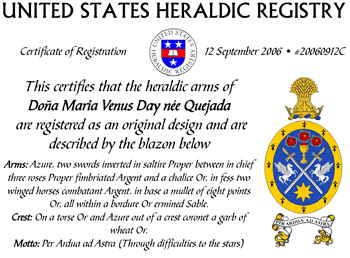U.S. Heraldic Registry
Registration of contemporary and historical American heraldry
Maria Venus Day née Quejada
Registration number 20060912C
This certifies that the heraldic arms of Maria Venus Day née Quejada are registered as an original design and are described by the blazon below

Registrations
2006 The International Register of Arms #0064
Design rationale
The design reflects the Quijada tradition of 3 roses. Our family is one of the oldest Spanish colonial families in the Philippines. We are common people, with a strong history with the land and the government that rules it. The golden chalice reflects our strong ties to the Catholic Church. There are two swords to symbolize our family's adumfight to stay alive under Spanish, American, and present day rule. We survived the travel to the Philippines. We survived under colonial law to Spain. We survived under the American occupation. We survived the atrocities and executions under the Japanese Invasion in World War II. We survived under the murderous and terrifying rule of the Marcos dictatorship. The star represents the "Evening Star," also known as the planet Venus in the night sky of which I am named after. The crown of wheat represents that our blood is tied to the land with live on. The Pegasus, the winged mythical horse, reflects our will to survive. We will never forget our ties to God, the Land, and our Family. The motto is Per Ardua ad Astra (Through difficulties to the stars).
Biographical information
Doña Maria Venus Arandia Rivera de La Pena Quejada was born April 24, 1970 in Cebu City, Philippines and was baptized in Our Lady of Guadalupe. She was married August 7, 1992 to Dr. Ian Day, MD. They reside in Florida.
M. Venus Day's parents are Don Rodolfo de La Pena Quejada and Nelda Arandia Rivera. Nelda Arandia Rivera's parents were Joaquin Rivera and Remedios Arandia. Their family history is summarized below:
- Pedro Rivera, Nelda Arandia Rivera's Grandfather, was a merchant who traveled between Cebu and Manila. He married Petra Pepito, whose brother is Francisco Pepito. When Pedro died, she remarried and had another child, Francisco Pilapil.
- Pedro and Petra’s children included Maria, Domingo, Consortia, Mercedes, and Joaquin.
- Joaquin Rivera married Remedios Arandia whose father, Severo, was a very active politician.
- Remedios' Aunt Paulina, sister to Severo, married Nicholas of Spain. Remedious’ other Aunt, Necifora, married Hermingildo Gullas, a landowner and farmer.
- Necifora’s children includes Rosario Gullas, the Dean of Graduate Studies at the University of the Visayas, the Honorable Paulino Gullas, Congressman and Attorney, and Don Vicente Gullas who founded the Visayan Institute in 1919 which later became the University of the Visayas in 1948.
- Don Vicente Gullas married Lady Josefina Rivera. Their children include the Honorable Eduardo Gullas (Attorney, Current President of the University of the Visayas, Congressman of the Philippines, and the Governor of Cebu), the Honorable Dr. Jose Gullas (Congressman of the Philippines and Executive Vice President of the University of the Visayas), and Madame Gliceria Gullas-Lucero (Comptroller & Senior Vice President of the University of the Visayas).
- The Arandia Family can orally trace its roots back to PEDRO MANUEL DE ARANDÍA SANTISTEBAN (Governor General of the Philippines born 1699 – died 1759) — Native of Ceuta, Spain of Biscayan descent, Knight of the Order of Calatrava, Gentleman of Bedchamber of the King of the Two Sicilies, captain of the royal Spanish guards and mariscal-de-campo of the royal armies; arrives at Manila, July (Retana, Estadismo, says June), 1754; reforms army and thereby incurs enmities; troubles with Moros continue; expels infidel Chinese and builds alcaicería of San Fernando; death, May 31, 1759; term as Governor General of the Philippine Islands, July, 1754-May 31, 1759.
- Don Rodolfo Quejada's father is Don Sulpicio Quijada/Quejada who married Rustica de La Pena. His Grandfather was Don Gregorio Quijada who married Agripa Caballes, and was the brother to Father Jose, Don Gervasio, Lady Francisca, Lady Magdelena, Lady Eugenia, and Don Mauricio Quijada.
- Don Gregorio's father was the legendary Don Francisco Quijada who married Ana Caballero.
- The Franciscan Friars were very much a part of the Quijada Family. Most of Guadalupe, the biggest populated village in the Philippines, belonged to the Quijada Family under Spanish, American, and present day rule. These Friar Lands were inherited by Don Francisco Quijada. The Quijada’s area was once 7 miles long by more than 3 miles wide, not including the hillsides. Today, the Quijada/Quejada Compounds still exists but is now broken into 6 units.
- Don Jose Quijada was the Mayor of Alaminos City, Philippines in 1818. He is related to Don Francisco Quijada but the relationship is not known as of now.
- Don Francisco Quijada married Doña Ana Caballero (who is from the Carcar region some 20 miles away and belonged to a family of powerful landowners) and was both landlord and master of his Tenants and Servants.
- Don Francisco Quijada’s son, Don Jose, became a Priest at the famous Seminario-Colegio de San Carlos, founded in 1595. Another son, Don Gervasio became so popular that a street was named after him. Streets named after the Quijadas and Arandias are still found today.
- Don Francisco Quijada’s daughter, Lady Magdelena, who never married was the appointed attendant of the statue of the most Holy Lady of Guadalupe, brought by ship from Mexico in 1564 during Don Diego Quijada’s post as Alcalde de Yucatan between 1551-1565.
- During a dispute between Don Sulpicio and his cousins (1954) over lands upon the death of Don Mauricio Quijada, Don Sulpicio changed the spelling of his last name to Q-u-e-j-a-d-a.
Registered by
Armiger
